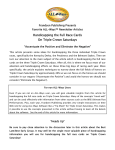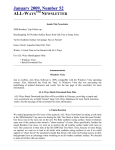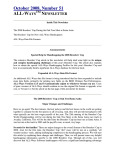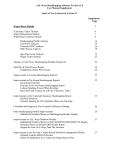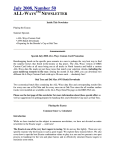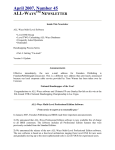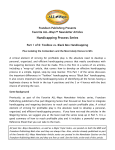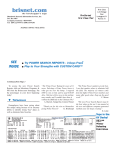Download January 2010 Number 56
Transcript
January 2010, Number 56 ALL-WAYSTM NEWSLETTER Inside This Newsletter Guest Article - New - “How I use ALL-Ways” Guest Article - Reprint - “Briefly, how I use ALL-Ways ALL-Ways Data File Formats The ALL-Ways User Manual Announcements Expanded ALL-Ways Data File Format A new standard ALL-Ways data file format will be introduced sometime in February 2010 that has been expanded to include more data fields, primarily for printing new fields on the BRIS Ultimate Past Performances. ALL-Ways Versions 13.5 and 14 automatically handle both the new format and the old format. Users of prior versions of ALL-Ways should continue to use the original format or upgrade, at no cost, to Version 14. This new, expanded format will be the standard format going forward. There will be a temporary link on the ALL-Ways Data File page to data files with the old format. See the article on the back page of this newsletter for details. Guest Articles Introduction The article that follows was written by a long time ALL-Ways Software handicapper. This particular article struck us as very informative, mainly because of how well wagering and handicapping are tied together. And, both the wagers played and the handicapping process are relatively simple and straightforward. We were particularly intrigued with the writer's concept of horses being on "offense" or "defense" in the stretch run. We also liked her concept of varying the amount wagered based on how many of the top 3 finish positions will most likely not be taken by the top 3 crowd favorites. The handicapping and wagering ideas and methods in this guest article will be of interest to ALL-Ways users and non-users alike. The writer makes references to a number of wagering and handicapping ideas that have been presented in past ALL-Ways Newsletters. We have included a list of these related articles later on in this newsletter. We have also included a reprint of a very short, but very effective, article on how another handicapper uses ALL-Ways Software to simplify his handicapping process and to save time. “How I Use ALL-Ways” (From Linda in Minnesota) I have been an ALL-Ways user for many years now. I have enjoyed fairly consistent profitability for most of this time. If there is one piece of advice I would offer to any and all horseplayers, whether they are ALL-Ways users or not, it would be to read the ALL-Ways Newsletters. The success I have achieved playing the horses, including using ALL-Ways as my primary handicapping tool is due, in large part, to the handicapping and wagering articles I read in ALLWays Newsletters. That's probably enough advertising for Frandsen Publishing. To understand my handicapping methods, it is helpful to understand how I play the races. First, I am a weekend player, typically playing two or three tracks on the days I play. I like the approach of being very selective in the races I actually wager on, but playing multiple tracks so I still get plenty of wagering "action". It may sound counterintuitive, but playing more tracks actually helps me stay disciplined to pass races that should really not be played. My "home track" is Canterbury Park in Minnesota, which has a live meet every summer. I actually do quite well at Canterbury, although my primary interest is in playing the higher caliber tracks. Specifically, I focus on simulcast racing from Belmont, Aqueduct and Saratoga in New York, Gulfstream, Calder and Tampa Bay in Florida, Churchill Downs and Keeneland in Kentucky, Arlington Park and Hawthorne in Illinois as well as Santa Anita and Del Mar in California. Even more important than the tracks I play are the types of wagers I make. First, I am more interested in winning often as opposed to winning big. So, I tend to focus on the simple wager types. Second, I prefer to play non-favorites, when I am confident the favorite will not win the race and, hopefully, will actually finish "off-the-board". I am a big believer in passing most races where I think the favorite is legitimate and has a good chance of winning. Both my interest in the simple wager types and my insistence of a false favorite really influence, perhaps even dictate, my handicapping methods. I focus most of my wagering on what Frandsen Publishing calls the “Win/Insurance Wager” and the “Show Partial Parlay Wager” and on the more traditional Exacta, Daily Double and Pick 3 wagers. For those new to the wager, the Win/Insurance Wager is a win, place and show bet on a single horse with a bet ratio of $2 to win, $4 to place and $12 to show. It is intended as a wager on a very solid win horse candidate going off at odds of about 4 to 1 or higher. The Show Partial Parlay Wager calls for betting 10% to 20% of your current Show Partial Parlay bankroll to show on a non-favorite horse going off at 4 to 1 or higher odds. Sometimes, as a result of my handicapping process, I will see a special opportunity to play a Trifecta and/or a 10 cent Superfecta, but I do not play these very often. I will explain more about my wagering after covering my handicapping process. Given my interest in the wagers described above, here are my primary handicapping objectives: - Assess how well the crowd favorite will likely perform. - Identify the most likely non-favorite candidates for the win and place positions. - Determine how many of the top three finish positions will likely not be taken by the top 3 public choices. As mentioned above, I focus mainly on identifying the win and place horses. This obviously says I do not focus on the show or 4th place horses. I have been very pleased with how this narrow win/place focus has made my handicapping process easier and faster. It only takes me about six or seven minutes to handicap a race and I am able to do all of this at the track. My approach is very pace oriented. I do extremely well using the Race Pace Shapes concept that I believe was first introduced in ALL-Ways software. I generally start by working to identify three horses: 1. The best early running horse 2. The best late running horse 3. The 2nd best late running horse Something I read in an ALL-Ways Newsletter lead me to this approach. It pointed out that when the horses are coming down the stretch and approaching the finish line, you are generally rooting for the front runner to hold on or for a late runner to pass the front runner before reaching the finish line. This logically leads to the Best Early/Best Late handicapping concept and approach that I use. Note that I look for the single best early running horse, but the two best late running horses. This is because I have observed, over the years, that the late runners provide most of the surprises and that the late runners generally tend to have higher odds. This makes logical sense because the stretch run is, after all, “closer” territory. It is where late runners are running their best during the race. In the stretch run, closers are on the offense and early runners are on defense. I start my handicapping process using the ALL-Ways Search Handicapping Report. It already lists the Best Early and the Best Late horses in separate ranked lists. The Best Early horses are based on the compound BRIS Total Rating. The Best Late horses are based on the compound BRIS Late Rating. [Editors Note: The BRIS Total Rating is the sum of the BRIS Early Pace Rating plus the BRIS Speed Rating. The BRIS Late Rating is the sum of the BRIS Final Fraction Rating plus the BRIS Speed Rating.] This is just a start because, when I say “best”, I mean more than just a single handicapping factor. I also give a horse special credit if it has been designated by ALL-Ways as a “Dual Qualifier”, meaning it is in both the Best Early and Best Late lists and/or if it has been designated by ALL-Ways as a Contender and/or if it has been designated by ALL-Ways as a Key Horse Candidate. All of these designations are on the ALL-Ways Search Handicapping Report. At this point I have usually identified the top 2 or 3 early runners and the top 2 or 3 late runners. I call the next step in my process the “Close Enuf” step. It is really the cornerstone of my pace oriented handicapping process. There are two things I do in this step. One is to determine if the front runners will likely be close enough to the finish line when they “run out of steam” that they will be able to hold on to their lead positions down the stretch run. The second thing is to determine which of the late runners will be close enough at the 2nd Call to have a decent chance of catching the leaders down the stretch. I use the ALL-Ways Top 10/Ranking report for this “Close Enuf” step. I look at three of the ranked lists on the report, specifically the BRIS Early Pace 2/3 factor, the BRIS Final Fraction 2/3 factor and the BRIS Combined 2/3 factor. [Editors Note: The BRIS Combine factor is the sum of the horse’s BRIS Early Pace Rating and BRIS Final Fraction Rating. The “2/3” notation indicates the factor is the average of the horse's best 2 out of its last 3 races]. Regarding front runners being close enough to the finish line, I look for two things. First, the early running horses must be at or near the top of the BRIS Early Pace list. If they are not, meaning there are other early runners with higher BRIS Early Pace Ratings in the list, they will not be able to optimally run their early pace style. Second, early runners must not totally collapse down the stretch run, which is what would likely happen if they are at or very near the bottom of the BRIS Final Fraction list. Looking at this positively, I will reward early running horses if they are at or near the top of the BRIS Early Pace list AND if they are near the middle or higher up in the BRIS Final Fraction list. Regarding late runners being close enough at the 2nd Call, I want the late running horses to be within 4 to 5 lengths of the leader at the 2nd Call. Since one Early Pace point is equivalent to one half length, I discount late running horses in the ranked BRIS Early Pace list that are more than 8 to 10 points lower than the top rated horse in the list, which is the horse that will most likely be on the lead at the 2nd Call. The BRIS Combined Rating is the sum of the horse’s Early Pace Rating and its Final Fraction Rating. I find this BRIS Combined Rating requirement to be particularly effective when my handicapping goal is to identify the best candidates for the win and place positions. I want the horses I play to be in or near the top half of the BRIS Combined ranked list. However, and this is very important, I am not impressed if an early runner got there with an abnormally high Early Pace Rating or if a late runner got there with an abnormally high Final Fraction Rating. Instead, I want early runners to have good Early Pace and acceptable Final Fraction figures so they can hold on down the stretch. I want late runners to have good Final Fraction figures down the stretch and acceptable Early Pace figures so they are close enough to the front runners at the 2nd Call. This “Close Enuf” step will often disqualify one or more of the early running candidate and/or one or more of the late running candidates. Now, I do some work to make sure the horses pass three fundamental tests: Competitive: I want decent BRIS Speed and BRIS Class Ratings and some indication of good or improving form (recent good finish, good works, etc.). Suitability: I want the horse to have demonstrated its ability to handle the distance and surface of today's race. If a horse is going back to a distance and/or surface it has not liked in the past, I will generally eliminate it. However, if it is going back to a distance and/or surface it likes, I reward the horse. Competent Jockey/Trainer: Here I am just looking for a jockey and a trainer who won't mess up the race. I do give extra credit to a horse if ALL-Ways designates the Jockey/Trainer combination as “Hot!”. This brings me to the final step in my handicapping. At this point I am generally down to the two best early and two best late running horses and I know enough about them to determine which horse(s) I like the best. In this last step, I want to assess the early pace pressure in the race and how each horse is likely to be affected. Once again, my handicapping process is very pace oriented. There are two features in ALL-Ways Software that are particularly helpful for this. One is ALL-Ways designation of a Race Pace Shape for the current race. The other is ALL-Ways designation of a Quirin Race Shape for every past performance race. Editors Note: The definitions below are central to the handicapping described in this article. Horse Running Styles: ALL-Ways assigns every horse one of four different Preferred Running Styles. They are “E” for Early meaning the horse only wants to be on the lead; “EP” for Early Presser meaning the horse is comfortable on the lead or up close to the lead; “P” for Presser meaning the horse wants to run in the middle of the pack; “S” for Sustainer meaning the horse prefers running at the back of the pack. The mention of early running horses refers to “E” and “EP” horses and the mention of late runners refers to “P” and “S” horses. ALL-Ways Race Pace Shapes: ALL-Ways assigns a Race Pace Shape to today's race based on the mix of different running styles in the field of horses. These individual Race Pace Shapes can be grouped into four categories. They are “FAST”, “LONE EARLY” “HONEST” and “SLOW”. Quirin Race Shapes: ALL-Ways assigns a Quirin Race Shape to every past performance race. The letter designations are “F” for Fast, “P” for Par, “A” for Average (slightly below par) and “S” for Slow. Each race is assigned two letters, the first for the early pace of the race and the second for the final time of the race. For example, a Quirin Race Shape of FP means the early pace was fast and the final time was Par. If today’s race has a “Fast” Race Pace Shape, early runners will be compromised by the heavy early pace pressure and late runners will be helped. I pay particular attention to past performance races with a Quirin Race Shape having a fast early pace designation (“F”). If today's race has a “Lone Early” shape, I check to see if the lone early running horse is likely to be able to exploit its "loose on the lead" advantage by holding on down the stretch. For both “Lone Early” and “Honest” shapes, I pay particular attention to past performance races with a Quirin early pace designation of “P” or “A”, which indicate “Par” or “Average” respectively. If today's race has a “Slow” Race Pace Shape, I look at past performance races with a Quirin early pace designation of “A” or “S” which indicates “Average” or “Slow” respectively. At this point, I have essentially completed my handicapping and have achieved my handicapping objectives. I have a good feel for how I think the favorite will perform, which was my first objective. And, I have identified what I believe to be, the best early running and the two best late running candidates for the win and place positions, which was my second objective. My extra focus on the late running horses has worked very well for the kinds of wagers I make. Anecdotally, if the favorite in a race does not win or place in a race, I have noticed that the win and place positions are generally taken by one early runner and one late runner or they are taken by two late runners. Having two non favorite early running horses finish in the win and place positions does happen occasionally, but it seems to me to be the exception. At this point I also have met my third objective of determining how many of the top three finish positions will likely not be taken by the top three public choices. This is an important consideration for my Win/Insurance and Show Partial Parlay wagers as I discuss below. This whole handicapping process only takes me 6 to 7 minutes for a race and I am ready to make my wagering decisions. The ALL-Ways handicapping reports I use to get to this point are the Contender Summary Report, the Search Report, the Top 10/Ranking Report and the Past Performance Report. Now, here are some thoughts on how I turn all this into wagers. First, if the situation is right in the race, I will play either a Win/Insurance wager or a Show Partial Parlay wager. I rarely play both in the same race, but there have been some exceptions. One very important characteristic of these wagers is that the place payoff in the Win/Insurance wager and the show payoff in both wagers will be lower if the top three finish positions are taken by the top three crowd favorites. To be precise, I should actually look at the place and show pools, but I find it easier, faster and pretty effective to just focus on the win odds. If the top 3 public choices will take the top 3 finish positions, I will not make either wager. On the other hand, if my handicapping indicates that at least one of the top 3 positions will be taken by a non top 3 crowd favorite, I will make a wager. If I have a horse I like for the win position and it is going off at 4 to 1 or higher, I will play the Win/Insurance wager. Frandsen Publishing recommends using 3 to 1 as the minimum, but I like the 4 to 1 minimum better. Note that I increase my Win/Insurance wager amount if I think two or three of the crowd favorite horses will finish off the board, but I stay with the $2 win, $4 place and $12 show ratio. If things do not set up well for a Win/Insurance wager, I will make a Show Partial Parlay wager. As Frandsen Publishing recommends, I do keep a separate cash voucher as my bankroll for this wager and I do use the “percentage of bankroll” approach to determine the size of each Show Partial Parlay bet. A little "trick" I use here is that the more top 3 public favorites I think will finish off the board, the higher the percentage of my Show Partial Parlay bankroll I will bet. If just one top 3 favorite will be off the board, I bet 10% of the bankroll. If I think two will be off the board, I bet 15% of the bankroll. If I think all three will be off the board, I play 20% of the bankroll. Again, the more top 3 public favorites that finish off the board, the better chance my show horse selection has of finishing in the money. If all the top 3 public choices are likely to take the win, place and show positions, I do not make the wager, again, because the show payoffs would just be too small. As for the Exacta, my favorite wager is a three horse box and I generally use the top early runner and the two top late running horses that I identified in my handicapping. On occasion I will add a fourth horse either in just the place position or add it to the box wager. I know this goes against the “experts” who generally recommend against boxing horses. But, it has worked well for me. When I make the wager, I have a pretty good feel for how likely it is that I will win the bet, I know the cost of the wager and I know the probable payoffs. If you have a good handle on these three things, the Exacta can be a very profitable wager. I also occasionally play Daily Double and Pick 3 wagers. I happen to play these exactly the way Frandsen Publishing recommends in their ALL-Ways Newsletters. This method requires that at least one leg of the wager not be won by the crowd favorite and it structures the wagers so you can actually win each Daily Double twice and each Pick 3 three times. I am running out of room in this article, so I will simply recommend that horseplayers read the Daily Double and Pick 3 wagering articles that Frandsen Publishing has posted in the Newsletter section of their Web site. One final comment: ALL-Ways software includes what are called Custom Search Definitions. These are personal angles the user can enter into the software. ALL-Ways then searches each race it handicaps for horses that qualify for the angle(s) and shows the search results on the Search Handicapping Report. Many of the “rules” I mention in this article can now be turned into these personal angles. I have just started working with this feature and, so far, I am pretty impressed. Maybe I can write a follow-up article when I have more experience with this feature. Related ALL-Ways Newsletters All ALL-Ways Newsletters are posted on the Frandsen Publishing Web site at www.frandsen.com and they are free. Here is a list of past newsletter articles that you may find helpful in support of the articles in this current newsletter. Handicapping Articles NL # Race Pace Shapes # 3 Quirin Race Shapes # 4 Handicapping Honest Pace Races # 8 Best Early - Best Late #18 The "Going Back" Spot Play #18 Pace Handicapping Process #21 So, Who Gets the Lead? #33 Handicapping Process Series #42-#48 Wagering Articles NL # Betting the Daily Double #10 Pass or Play? #12 Betting the Pick 3 #15 Show Partial Parlay Wager #28, #29 Curse of the Legitimate Favorite #30 Win/Insurance Wager #40 Betting the Exacta #50 Wagering Series #36-#41 “Briefly, How I Use ALL-Ways” Originally Published January 2006 I start by “trusting” ALL-Ways software's top 4 selections, Contender designations and Dangerous Non Contenders designations (DNCs). I do not start from scratch in my handicapping. Instead, I take the approach of trying to validate the decisions already reached by ALL-Ways software. There is a big difference in these two approaches. Validating ALL-Ways software is much faster and less prone to information overload. The first thing I do is to determine, if I confirm ALL-Ways software selections, whether or not I would bet the race. I make any kind of wager from win or place or show to Exactas or Trifectas or Superfectas to Daily Doubles or Pick 3s or Pick 4s. It all depends on the odds and probable payoffs and how confident I am that I have the race figured out. I pretty much use the wagering strategies spelled out in ALL-Ways Newsletters. Finally, I look for any high priced horses that ALL-Ways software may have missed. I look at pace considerations here, particularly late runners that may score at a good price. I also really like ALL-Ways Dangerous Non Contenders that have been designated as such because of Hall pace or speed figures. The Hall figures point out a lot of high priced horses, particularly if they are changing distance. The primary reports I use are the Contender Summary, the Paceline Report, the Search Report, the Top 10/Ranking Report and the Past Performance Report. My wife uses the same ALL-Ways software handicapping reports except she likes the BRIS Ultimate Past Performances, which are free because I can use ALL-Ways data files to print them. I have also been using a new report in the Beta version of ALL-Ways Version 12. It is called the Spot Play/Final Process Report. It is fantastic for conducting a quick review of ALL-Ways software selections and for identifying high priced long shots, in an orderly manner. I used to spend a lot of time handicapping the night before from “the bottom up”. I generally play three tracks, so it did take some time. But, I found that I was pretty much just validating what ALL-Ways software already determined. So, I decided to handicap at the track, still playing two or three tracks. It has worked out great. I do not bother to handicap some races because, if ALL-Ways software is correct, there is simply not a good wager available for the race. The races that I do handicap further to validate ALL-Ways software selections and to look for a long shot or two, only take maybe 5 to 6 minutes. This is easy to do at the track. We do get to the track about an hour before the first post time. I use this time to glance through all the races to see if there may be any good multi-race wager(s) (double, P3, P4). If I find some opportunities, I use the hour to look at each leg in the wager so I am prepared to make the wager if the odds hold up near post time. ALL-Ways Data File Formats The original ALL-Ways data file (Format 1) includes 1,500 fields of data. A new data file (Format 2) will be available in February 2010 that is expanded to 2,500 fields. The new information, at this time, applies only to printing the BRIS Ultimate Past Performances. The old format has the file extension of “.ALW”. The new format has a file extension of “.ALL”. ALLWays software versions 13.5 and 14 automatically handle both formats. Format 2 will be the new standard format. If you have either ALL-Ways Version 13.5 or Version 14, the latest version, you do not need to take any action. When you download an ALL-Ways data file, you will automatically get the new Format 2 and ALLWays will automatically handle the new format. If you are using an older version of ALL-Ways, there will be a link on the ALL-Ways Data File Page as well as the ALL-Ways Custom Card Page, to download the old format. However, we do recommend upgrading to the most recent version of ALL-Ways, which is currently Version 14 at your earliest convenience. This upgrade is particularly important if you use special ALLWays data files such as Batch Download Files, Archived Files and Meet Subscription Packages. ALL-Ways Software Version 14 is free and is available on the ALL-Ways Free Software Page on the BRIS Web site. It is very easy to download and install the new software. If you have questions or would like assistance upgrading to Version 14, you may contact BRIS Technical Support at 800- 354-9206 or you may contact Frandsen Publishing at 952-937-9180. The ALL-Ways User Manual For handicappers who are new to ALL-Ways Software, we generally recommend they start by reading Chapter 1 of the ALL-Ways User Manual and then follow the directions in Chapter 2, which will point to other parts of the manual if additional information is needed. ALL-Ways Software comes with a comprehensive User Manual designed as a reference guide as opposed to being read cover-to-cover. We recommend calling BRIS at 800 354 9206 to order the User Manual, all printed on both sides of the paper and contained in a 3-ring binder. There is a nominal S&H charge. While waiting for the manual to arrive, we suggest printing Chapter 1 and Chapter 2 of the full manual that is available on the ALL-Ways Free Software page on the BRIS Web site. ALL‐Ways Home Page © Copyright 2010 Frandsen Publishing Corporation PO Box 1439 Minnetonka, MN 55345 All Rights Reserved How to contact Frandsen Publishing Phone: 952.937.9180 E-Mail: [email protected] Website: www.frandsen.com Be sure to check the What’s New page on our Website for the latest announcements and alerts.








